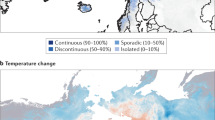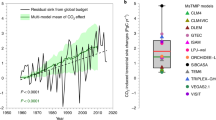Abstract
Methyl chloride is the largest natural source of ozone-depleting chlorine compounds, and accounts for about 15 per cent of the present atmospheric chlorine content1. This contribution was likely to have been relatively greater in pre-industrial times2, when additional anthropogenic sources—such as chlorofluorocarbons—were absent. Although it has been shown that there are large emissions of methyl chloride from coastal lands in the tropics3,4, there remains a substantial shortfall in the overall methyl chloride budget. Here we present observations of large emissions of methyl chloride from some common tropical plants (certain types of ferns and Dipterocarpaceae), ranging from 0.1 to 3.7 µg per gram of dry leaf per hour. On the basis of these preliminary measurements, the methyl chloride flux from Dipterocarpaceae in southeast Asia alone is estimated at 0.91 Tg yr-1, which could explain a large portion of missing methyl chloride sources. With continuing tropical deforestation, natural sources of chlorine compounds may accordingly decrease in the future. Conversely, the abundance of massive ferns in the Carboniferous period5 may have created an atmosphere rich in methyl chloride.
This is a preview of subscription content, access via your institution
Access options
Subscribe to this journal
Receive 51 print issues and online access
$199.00 per year
only $3.90 per issue
Buy this article
- Purchase on Springer Link
- Instant access to full article PDF
Prices may be subject to local taxes which are calculated during checkout

Similar content being viewed by others
References
Butler, J. H. Better budgets for methyl halides? Nature 403, 260–261 (2000).
Butler, J. H. et al. A record of atmospheric halocarbons during the twentieth century from polar firn air. Nature 399, 749–755 (1999).
Khalil, M. A. K. & Rasmussen, R. A. Atmospheric methyl chloride. Atmos. Environ. 33, 1305–1321 (1999).
Yokouchi, Y. et al. A strong source of methyl chloride to the atmosphere from tropical coastal land. Nature 403, 295–298 (2000).
Berg, L. Introductory Botany (Saimders College Publishing, New York, 1997).
Li, H.-J., Yokouchi, Y. & Akimoto, H. Measurements of methyl halides in the marine atmosphere. Atmos. Environ. 33, 1881–1887 (1999).
Yokouchi, Y. et al. Isoprene in the marine boundary layer (Southeast Asian Sea, Eastern Indian Ocean, Southern Ocean): Comparison with DMS and bromoform. J. Geophys. Res. D 104, 8067–8076 (1999).
Watts, S. F. The mass budgets of carbonyl sulfide, dimethyl sulfide, carbon disulfide and hydrogen sulfide. Atmos. Environ. 34, 761–779 (2000).
Food and Agriculture Organization of the United Nations State of the World's Forests 1997 (UN Food and Agriculture Organization, Rome, 1997).
Takhtajan, A. Floristic Regions of the World (Univ. California Press, Berkeley, 1986).
Manokaran, N. in Conservation, management and development of forest resources (ed. See, L. S. et al.) 41–60 (Forest Research Institute Malaysia, Malaysia, 1998).
Aiba, S. & Kitayama, K. Structure, composition and species diversity in an altitude-substrate matrix of rain forest tree communities on Mount Kinabalu, Borneo. Plant Ecol. 140, 139–157 (1999).
Yamakura, T., Hagihara, A., Sukardjo, S. & Ogawa, H. Aboveground biomass of tropical rain forest stands in Indonesian Borneo. Vegetatio 68, 71–82 (1986).
Moore, R. M., Groszko, W. & Niven, S. J. Ocean–atmosphere exchange of methyl chloride: results from NW Atlantic and Pacific Ocean studies. J. Geophys. Res. 101, 28529–28539 (1996).
Lobert, J. M., Keene, W. C., Logan, J. A. & Yevich, R. Global chlorine emissions from biomass burning: Reactive chlorine emission inventory. J. Geophys. Res. D 104, 8373–8389 (1999).
Rhew, R. C., Miller, B. R. & Weiss, R. F. Natural methyl bromide and methyl chloride emissions from coastal salt marshes. Nature 403, 292–295 (2000).
Watling, R. & Harper, D. B. Chloromethane production by wood-rotting fungi and an estimate of the global flux to the atmosphere. Mycol. Res. 102, 769–787 (1998).
Redker, K. R. et al. Emissions of methyl halides and methane from rice paddies. Science 290, 966–969 (2000).
Li, H.-J., Yokouchi, Y., Akimoto, H. & Narita, Y. Distribution of methyl chloride, methyl bromide, and methyl iodide in the marine boundary air over the western Pacific and southeastern Indian Ocean. Geochem. J. 35, 137–144 (2001).
Acknowledgements
We thank T. Konishi for permission to use the Rainforest Glasshouse, Tsukuba Botanical Garden; S. Yamauchi for permission to use Yanbaru Subtropical Forest Park; P. Ciccioli for suggestions on the measurements of flux; T. Okuda, A. Takenaka, K. Kitayama and T. Ueda for comments and discussion; and T. Enomoto for help with sampling.
Author information
Authors and Affiliations
Corresponding author
Ethics declarations
Competing interests
The authors declare no competing financial interests.
Rights and permissions
About this article
Cite this article
Yokouchi, Y., Ikeda, M., Inuzuka, Y. et al. Strong emission of methyl chloride from tropical plants. Nature 416, 163–165 (2002). https://doi.org/10.1038/416163a
Received:
Accepted:
Issue Date:
DOI: https://doi.org/10.1038/416163a
This article is cited by
-
Wet deposition of atmospheric inorganic reactive nitrogen (Nr) across an urban-industrial-rural transect of Nr emission hotspot (India)
Journal of Atmospheric Chemistry (2021)
-
Tropospheric OH and stratospheric OH and Cl concentrations determined from CH4, CH3Cl, and SF6 measurements
npj Climate and Atmospheric Science (2018)
-
Shifts from methyl chloride sink to source functions within a coastal salt marsh in eastern China: an examination of the effects of biomass burning prohibition policies
Environmental Science and Pollution Research (2018)
-
Effect of temperature on the methyl chloride production rate in a marine phytoplankton, Phaeodactylum tricornutum
Journal of Atmospheric Chemistry (2017)
-
Global Modelling of the Atmospheric Methyl Bromide Budget
Journal of Atmospheric Chemistry (2006)
Comments
By submitting a comment you agree to abide by our Terms and Community Guidelines. If you find something abusive or that does not comply with our terms or guidelines please flag it as inappropriate.



